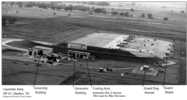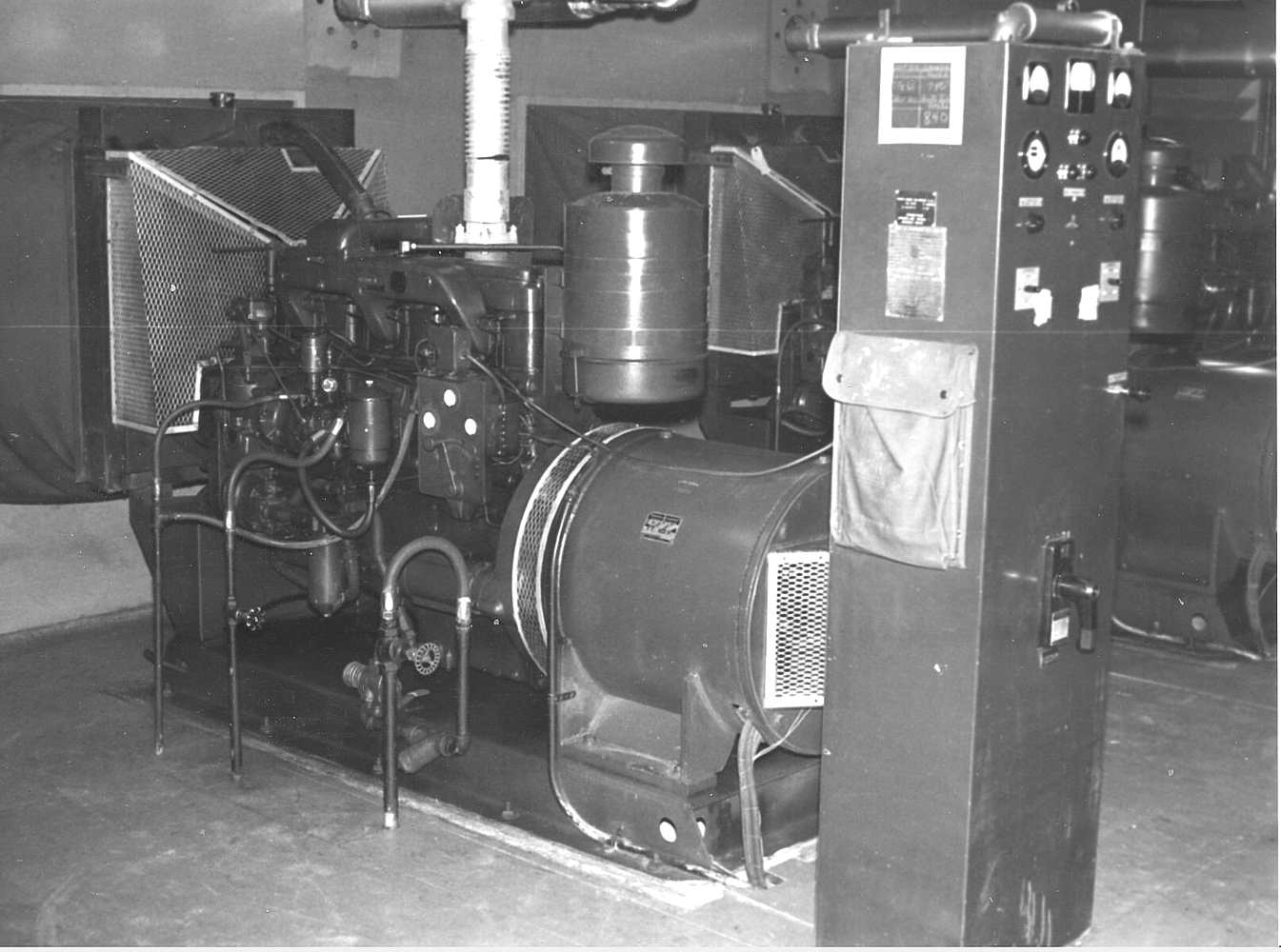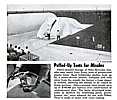Return to home page
Goto Next Section
Annotated aerial image of SF-88 Launcher Area 124 K Bytes
Also see
- - Lesson 1. Introduction to the Nike Hercules Missile and Launching Area 0.3 megabytes
- - part of Nike Missile and Test Equipment
- - Clinton Crane's - Nike Missile Assembly & Service Area for volunteer docents at SF-88, 2.1 MBytes .pdf, Rev 2, Sept 4, 2013
Current pictures of Launcher area of the F-45 Launcher area at Medical Lake outside Spokane, Wa (Fairchild AFB). by Marc Spurgeon, June 2008
The mission of the Launcher area was:
- Preparing and maintaining the missiles for flight
- (If underground magazines,) Elevating missiles to surface for launch
- Selecting which launcher and missile for next launch
- Erecting and Launching missiles
- Keeping the missile launching equipment filled with ready missiles during alerts.
- Launch the missile/booster so the booster falls into the Booster Disposal Area
To help succeed in the above mission, the Launcher Area:
- Usually located 1000 to 6000 yards from the IFC (radar area),
must have line of sight to the IFC Missile Tracking Radar
- Was near Missile Assembly area
- Surrounded by two stout fences,
and guarded by armed troops and guard dogs
- Had a guard_dog kennel
to provide shelter for the guard dogs
- Connected to commercial power,
with converters to 400 hertz (cycles per second)
- Had electrical generating equipment
and fuel, in case of alert or local power failure
- Had telephones and radios
for communication with other site areas
- Had a Launch Control Trailer
a) to raise/lower launchers,
b) select missile to fire
c) with test mast to to help calibrate/test the Missile Tracking Radar
d) (potentially) fire a missile
- Had ready missiles
and boosters fully prepared for flight
- Either underground storage with elevator from magazine
- Or had aboveground storage with protective building
- Had launchers
to erect (raise vertically) missiles and hold them ready for launching
and racks between launchers for transportation and storage - Had earthen berms to deflect potential explosions
- Rate of fire of missiles
- Had an access road,
drinking water, and latrine.
- And a Booster Disposal area
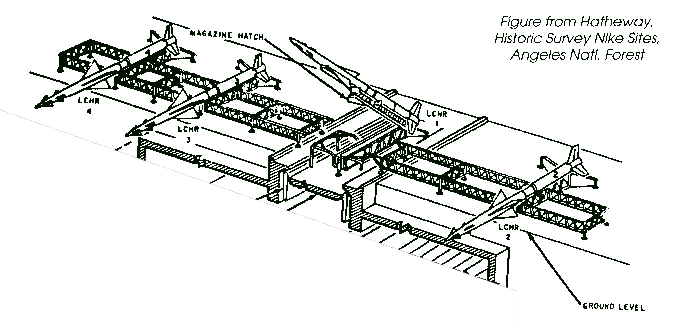
A drawing of the above ground launching rails, 4 launchers, 4 Nike Ajax missiles,
and the elevator.
Nike Hercules (slightly larger) used the same
launchers. Note that one of the launchers is on the elevator.
1) Usually located 1000 to 6000 yards from the IFC (radar area)
must have line of sight to the IFC Missile Tracking Radar
-
The Launcher Area had to be far enough
away from the Missile Tracking Radar so that the rapid ascent of the missile (25 g's)
did not exceed the slew rate and acceleration rate of the MTR.
One to three miles was the usual separation distance. The standard length of
IFC to Launcher area cable provided was 6,000 yards.More cable could be provided
and used with no particular problem. If the launcher area was
on the other side of a river or other body of water, other communication links
could be arranged.
The Missile Tracking Radar (MTR) also had to have line of sight with (see) the erect missiles and the Launcher Area test mast. As mentioned else where, Nike radar waves travel basically straight lines. The MTR had to be locked-on (track) the missile before launch.
Another limit that was rarely a bother was that the tracking radars could only depress (point below the horizon) about 10 degrees. The launcher area could not appear below that angle or special changes had to be made.
2) Was near Missile Assembly area
-
There was a big advantage of having the Launcher Area near to or adjacent to the
Missile Assembly area. The continual transportation of missiles (especially Ajax
missiles with their very reactive liquid fuels) between the assembly and launcher areas
mandated their being as close as practical.
This was usually no problem.
For more information about test equipment to be found in the Missile Assembly area, see
- Lesson 4. Missile Test Equipment - 2.2 megabytes
1960 Photos including of fueling an AJAX
And the Administrative Area was usually within easy walking distance. This eliminated transportation problem of the larger launcher/assembly crews to and from the mess hall and barracks.
- Lesson 4. Missile Test Equipment - 2.2 megabytes
3) Surrounded by two stout fences, and guarded by armed troops and guard dogs
-
The Nike Ajax (with warheads of conventional explosives) used one fence and no dogs.
Hercules had nuclear warhead capability, and the Army defended this increased capability and risk vigorously. There are rumors (stated and denied) that some launcher areas were defended with 50 caliber machine guns. The dogs patroled the area between the two 8 foot 'cyclone' fences, which also could be lit.

Tim Tyler sent this image taken at Presidio of SF 'Pet' Cemetary 
from John Miller
450 K bytes - Feb 2006This is a pic of my wife brother who was station at Ft. Barry around late 1958 early 1960 ? He told me a lots about this dog "Prince" Myron passed away a few years ago and this photo was sent to us by an old Aunt living in that part of calif. We have no way of getting any information on dogs that were train there and was very surprise to learn that there is still Dog Kennels. Any information On when Myron was there or on the dogs that were trained @ Ft. Barry. I think the dog [in photo] had to be destroyed for some reason. If any records on Myron still exist we would sure like to know. Till the day he passed away he always had a German Shepard named "Prince"
- Kernell J Miller - Brother in Law
Las Vegas,Nevada - 702 736-7530Guarding Nuclear Hercs Overseas, from Charles Everett December 2007
- C Team, 35th USAAD, 1983 - 1985, 3/26th German FlaRak (Nike)
Hello Ed: Some information on the security precautions for guarding Nikes on NATO bases (in Germany at least). There were usual three firing sections, two of which contained missiles with nuclear warehads. The Germans referred to them as "XS" and "XL" warheads (XS = small KT yield, XL = large KT yield).
The US Army personnel were responsible for internal security (inner fence line containing the missile hangers) and the host nation for external security. The base had a double fence with guard towers situated between the double fence. The Germans manned the towers with luftwaffe security personnel and at night time, civilian security personnel to include dog handlers. There were usually four (4) towers to provide a 360 degree veiw of the launching area.
The US Duty Officer or NCO exercised the Host Nato security reaction force on a daily basis. This was a squad size element that consisted of a two man fast reaction recon team equipped with G-3 assualt rifles, NBC gear and communications. The squad which followed consisted of 8 men with G-3 assualt rifles, a MG 3 (MG42 clone), NBC gear and communications. The response time for the first part of the team to arrive at a predetermined location was 2 minutes with the rest of the squad within 5 minutes.
If the situation warranted reinforcements, a special code word would be issued and the IFC personnel would respond, providing a platoon size response force, response time was 30 minutes. If a platoon size element could not handle the threat, then personnel from the Host Nation administration area would respond, providing a company response. The response time for the administration personnel was 60 minutes. As another resource, the Host nation civilian police would also respond. There were also a special codeword set up for duress/hostage situations.
If weather or facility site conditions (High snow, grass, fog, etc.) were present, the US Security representative code use a special codeword for reduced visibility. The IFC would dispatch personnel to the launching area to set up a 360 degree internal security circle. Unfortunately by providing these reinforceing security measures, the Host Nation Nike unit had to seperate itself from the air defense mode and go to the ground defense mode. Usually the Host nation regimental headquarters received a report whenever the battery had to stand down from the air defense mode.
There were emergency explosive SHAPE charges located in the launching areas to destroy the US warheads on the missiles if necessary. If there was no time to destroy the warheads, a non-destructive immobilization could be accomplished by pulling the wires and cabling off inside the missile to prevent their nuclear use (if immobilized, they could only produce a HE explosion). The emergency destruction of the Nikes was practized by US personnel on a regular basis.
A daily site check was also made of the security perimeter of the launching area to include operational lighting, height of grass, condition of perimeter fencing, alertness of tower personnel. All nuclear release codes were in a two man safe and required a "B" and "A" side (NCO, E-5 and above and Officer). The safe had two tumblers - one man knew one combination, the other man had the other combination.
The US Brigade sent out regular authenication exercises to ensure proficiency with nuclear release procedures. The missile hangers had alarms on their doors (IDS = Intrusion Detection System) which sounded at the US Custodial guardhouse located at the entrance to the launching area. Anyone seeking access to this inner area had to be on an access roster or escorted. As for the hangers, only two persons with the same knowledge could access the hangers - I could not access the hangers to work on the missile warhead with a guard as my second person, it should be a missile technician who knows exactly what i am doing.
We also practiced the dismantling and transport of the missiles via a convoy system if the site had to be evacuated. The Host nation police would support the convoy with traffic control measures. From what I can determine, there were usaully four(4) Nike batteries per battalion for the German Air Force. Each battery had approximately 10 US controlled warheads (8 smaller range kiloton warheads and 2 larger range kiloton warheads). It has been estimated that for the Nike Hercules weapons system only, some 300 nuclear warheads were deployed in Europe.
There were a reserve stockpile of warheads kept at various ordnance depots throughout europe to support various areas in case their stockpile was depleted during wartime use. Overall, I feared the civilian guardforce more than the Luftwaffe security force. The civilians were more motivated than the Luftwaffe Security Force, since many members of this security force were conscripts and had a 18 month military service obligation to fulfill.
I can remember one night when I was checking the security of the launching area. I was challanged by a civilian guard in one of the towers. I heard "Halt, stehen bleiben" (Halt, stand still). Then I heard the bolt go forward on his G-3 Assualt rifle, chambering a round to fire. The guard then said "Funf schritte vor treten" (Come forward five steps). Wo ist ihr Ausweiss? (Where is your identification?). Kennwort? (password). After going through this - I could finally pass. On the way back to the German security entry point, one of the German civilian dog handlers was standing in the treeline in the dark. As I approached, he let his little German shepard leap out at me and scare the hell out of me.
So much for a little on special weapons security overseas in Europe.
Regards,
- Kernell J Miller - Brother in Law
4) Had a guard dog kennel to provide shelter for the guard dogs
-
There was a wire fenced kennel for each (of 4 (or more?)) dogs. There was also a small
shed for dog food and supplies.
The kennel area was basically a 70 foot diameter lump in the outer fence. Releasing a dog from its kennel released it into the space between the two fences. No further handling nor door opening was necessary.
5) Connected to commercial power, with converters to 400 hertz (cycles per second)
-
As with the IFC, the Launcher Area was connected (when possible) with local
commercial power - to save fuel and wear and tear of the generators and people.
commercial power -----+-------> Elevator hydraulic pumps (if used) (60 or 50 Hertz) | | V +--------------+ | converter to |--> Launchers and associated equipment | 400 Hz power | +--------------+There was one converter for each group of 4 launchers.
6) Had electrical generating equipment and fuel, in case of alert or local power failure
- The Launcher Area generators were quite large (??? KW) 60 hertz units to handle the underground hydraulic elevator(s). The launchers used 400 hertz power for the hydraulic pumps to raise the missiles to an erect (vertical) position.
7) Had telephones and radios for communication with other site areas
- The Launch Control Officer could in theory perform his function without voice communication with the IFC. In practice, he had phone and an emergency radio as discussed in telephones and radios.
8) Had a Launch Control Trailer
Most pictures in this section were taken by Greg Brown
c) with test mast & transponder to to help calibrate/test the Missile Tracking Radar
d) (potentially) fire a missile
9) Had ready missiles
and boosters fully prepared for flight
a) to raise/lower launchers,
b) select missile to fire
c) with test mast to to help calibrate/test the Missile Tracking Radar
d) (potentially) fire a missile
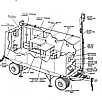

Alec Gyorfi scrambled up to set up ladder for
Ed Thelen, Rod Brimhall
and Greg Brown, taking picture
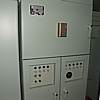
Trailer Heater
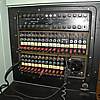
Switchboard
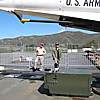
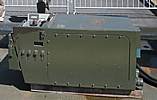
Jerry Freight and Greg Brown watching Hercules erecting.
For convenience of demonstrations, this box has been placed on the elevator.
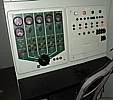
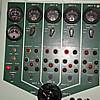
...
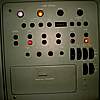
Alert status and other indicators and controls
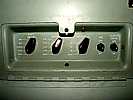 <
<Behind the "Manual Orders" door.
If automatic cable communication with the IFC (and battery control officer) was inoperative,
the two areas could effectively operate using voice radio or telephone.
Information to IFC - missile launcher selected, missile status, ...
Information from IFC - gyro azimuth, launch command
- the Launcher Area can set the gyro azimuth and fire the missile
Missile steering and burst commands are via the Missile Tracking Radar
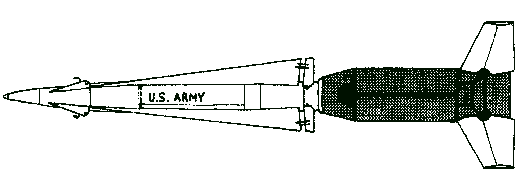
A drawing of a Nike Hercules, the successor to the Nike Ajax.
Featured a range 90 miles, speed mach 3.6, used most of the same launching facilities as the Ajax, and also nuclear capability and easier, safer servicing.
For more information "right now", you may jump ahead to missiles. (Use the "back" function to return here.)
10-a) Had underground storage for ready missiles and war heads
-
In the United States, explosives regulations dictated storing explosives
of this magnitude in areas of over 100 acres. This was a big, unexpected
problem that the Army Corps of Engineers seem to have discovered late in
the planning of the Nike defenses of the U.S.
But the land acquition costs of the area in metropolitean and suburban areas would be excessive and cause even more problems than already existed for the siting of the IFC areas. So the explosives regulations and land acquition costs were (in most cases) bypassed by storing the missiles underground, and raising them to the surface for servicing and launching only.
Many suburban launcher areas were about 30 acres in size. There were many variations. From Bud Halsey :
"... The overall size of our site (SF-88) is: launching area-approximately 30 acres (with two underground magazines; IFC approximately 7 acres and administrative area--about 1 acre. Other factors that affect the overall size of the Nike sites include the terrain and the location (sites in expensive suburban areas were intentionally made smaller to hold down the cost of buying the land). The use of underground magazines reduced the acreage required for the launching area. For example, the launching areas in the Anchorage or Fairbanks, Alaska sites, where the missiles were stored in separate ABOVE GROUND magazines, had considerably more acreage (about 140 acres) than similar sites in the "lower forty eight".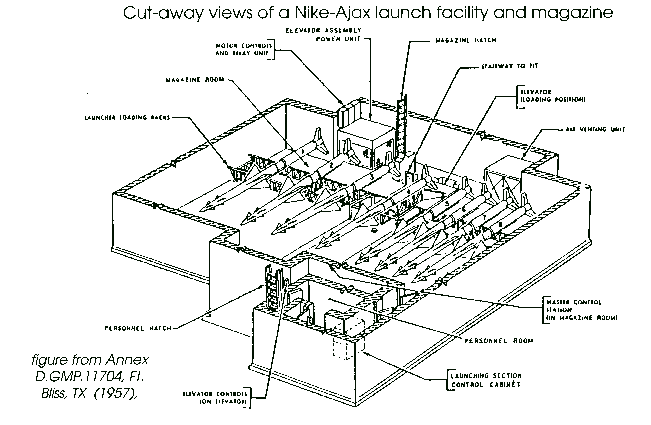
A drawing of the underground facilities.
This is the same plan as used at the site SF-88 (being restored). The "magazine room" was square, 60 feet by 60 feet and was 10 feet high to the bottom of the beams that supported the ceiling. There were no supporting columns in that area. There was a 57 foot long missile elevator in the center of the room to permit missiles to be moved between the this under ground storage area and the launchers above ground. The elevator "pit" was 6.5 feet below the floor of this room. The little room marked "personnel room" was 6 feet by 10 feet and contained the Launching Section Control Cabinet.
A drawing of the underground facilities (showing Nike Ajax missiles).
Each Launcher Section in a permanent site (most continental U.S. sites) had an underground storage area (magazine), with access through
- the missile elevator,
- a stairway with a blast resistant door on the top and bottom
- crew escape hatch, a squarish, concrete surface structure with a single horizontal counterweighted steel door.
Generally, the distance from the concrete pad above ground where the satellite launchers rested down to the interior ceiling of the magazine was seven feet. (communication from Bud Halsey )
The small protected room at the lower center of the drawing contained all of the controls for
- raising and lowering elevator
- selecting the missile to be launched
- raising and lowering the individual launchers
- manually firing a missile if the signal cable from the IFC failed (using inputs from voice radio)
From Bud Halsey :
" ... there were several types of magazines. These
include:
| Type Magazine | Length | Width | Comment |
| 1. Type A* | 42 feet | 63 feet | (Ajax only) |
| 2. Type B | 49 feet | 60 feet | (Ajax only) |
| 3. Type B (Mod) | 49 feet | 60 feet | (Universal Ajax & Hercules) |
| 4. Type B (RS) | 49 feet | 123 feet | (Rising Star - Greenland only)
Each magazine had 2 (two) elevators Each site had 2 or 3 magazines |
| 5. Type C* | 42 feet | 63 feet | (Ajax only) |
| 6. Type C (Mod) | 42 feet | 63 feet | (Hercules) |
| 7. Type D | 62 feet | 68 feet | (Hercules) |
If your question deals with how far below ground the magazines are, The answer is about 30 feet. There is a pit below the floor of the magazine about 10 feet below the floor where the sump pump, air and cable conduits and elevator shaft and equipment are located."
The thickness of the concrete varied (by blueprint) from 12 inches to 24 inches thick. The "as built" for site SF-88 shows it from 12 to 22 inches thick. The variation is because some external walls are thicker than others and within the interor of the magazines are many load-bearing concrete beams overhead that are 22 inches thick. (communication from Bud Halsey )
10-b) Had an elevator to raise/lower the missiles from/to the underground
This elevator connected the above ground launchers with the below ground magazine (place to store ammunition). It was about 45 feet long and 8 feet wide (the booster fins were at an angle like an 'X' so did not require full span width.)
The elevator was raised hydraulically (hydraulic fluid - like your car brakes) and took about 20 seconds in either direction. Operation was suprisingly smooth and precise - well I imagine there must have been some interesting exceptions.
On raising, the elevator would over shoot about 2 inches to allow 4 iron bars to slide into holes in the elevator door, then the elevator would gently settle down into a locked position.
There were 2 long elevator doors that were normally closed when the elevator was down.
There was a launcher on the elevator, and missiles could be launched from it. Missiles were normally raised and lowered in a horizontal position.
IFC people used to imagine a hurried situation, and have the elevator rising with a fresh missile, and while the elevator was rising the launcher was elevating the missile to a vertical position - so that as soon as the elevator locked you could launch the missile. Sounded and would look dramatic - launcher people did not like to think of it - I heard a rumor that some site tried it, and it worked until a 'fix' to the control interlocks and they crunched a missile.
From Bud Halsey " ... the elevator doors, in the open position, hang down, and in the closed position are raised to form a cover over the magazine (and the elevator itself now in the "down" position). The closed doors do indeed keep rain, weather and outside stuff out of the magazine. When the elevator is raised, it does indeed go up for several extra inches when it reaches the top, but it settles on four steel locking bars (not sealing strips). The locking bars support the elevator for firing. Without the elevator being on locking bars, upon firing the downward thrust of the rocket cluster would drive the elevator and missile downward overcoming the hydraulic pressure that raised it initially. "
Also from Bud Halsey " ... (some people) ... think the launcher on the elevator, upon firing, places the magazine in some sort of jeopardy from fire and burning debris. There is always that possibility, but the risk is pretty minimal for the following reasons: When launcher #1 is raised to its near vertical firing position, the nozzle ends of the rocket motor cluster are not positioned directly above the elevator but are actually positioned above the blast deflector behind and off the elevator. With the extremely large thrust generated at the moment of firing, the missile, and its trail of flame, is not near the elevator for more than a split second. Remember, this missile goes off like a bottle rocket, not like the space shots we see on TV where the rocket seems to burn on the launcher for a long time before it begins to rise slowly off the pad."
From Terry Kerns
During alerts, after launcher 1 (on the elevator) was
fired, the section leader and crewman 3 and 4 would come out into the
magazine and:
|
11) Above Ground Storage with Protective Building
from Mark Morgan, May 17, 2001
The SAC base
defenses built in 1959 - Barksdale, Bergstrom, Dyess, Lincoln/Offutt, Robins,
Turner, Walker - had above-ground magazines, basically berms. Mountain Home
and Sheppard would've had the same above-ground, two site Hercules defenses
if they'd ever been built. MK
Question from Ron Plante:
12) Had launchers
to erect (raise vertically) missiles and hold them ready for launching
Many launching sites in Florida (high water table or haste in Cuban incident),
Alaska (permafrost), and off shore used above ground storage. The launchers and
connecting rails were identical with the below ground storage systems.
(HM-69 )
Photo from Ted Swanson
Also most sites away from population centers were constructed this way,
SAC sites, Korea, Germany, Greenland, ...

The Nike sites built at a few SAC bases in the mid-1950s - Fairchild,
Travis, Ellsworth, Loring - had standard in-ground magazines.
What are the large white "tubes" next to the missiles at most of the pads?
They're also shown at Bellows Field, OA-32 (scroll down to the Cold War era):
http://www.airfields-freeman.com/HI/Airfields_HI_Oahu_S.htm#bellows
Reply from Doyle Piland < dpiland @ zianet . com > - Apr 07, 2015

A drawing of the above ground launching rails, launchers, missiles, and elevator.
When the launcher and missile were "erect", the launcher and missile pointed almost vertically - because "what goes up must come down". :-| and no one wants to be under a booster as it burries itself 50% or more into the ground. ( About 50% into hard desert rocky clay as at Red Caynon, New Mexico. )
The launchers are pointed toward the Booster Disposal Area and are set to be "erect" at a slight angle from vertical ( say 87 degrees ) so that the booster will fall into that Booster Disposal Area. During trainning, we asked what would happen on a windy day - would the wind blow the boosters out of the assigned area. We were advised that this problem had been tested, and the heavy booster took a long time to be blown far during its about 45 second (I forget) flight. ( When the booster falls away from the more streamlined missile due to higher drag, it continues going up a surprisingly long way and takes a while to impact the earth. )
This drawing shows the four launchers (one on the elevator) connected by racks which enabled the missiles to be moved side ways from launcher to launcher.
This side ways movement was done manually. The missile rested on a launching rail. This launching rail had little wheels (not usually visible) which permitted it, and the missile, to be move side ways from launcher. Two men were used to push the missile, one pushing near the nose of the missile, and one near the booster fins. The rolling was rather easy, (about 20 pound force) but two men were recommended to prevent the wheels from binding. The launching rail also carried electrical signals from the launcher to the missile. Basically, the missile was plugged into the launcher rail, and the launcher rail was plugged into the launcher, and the launcher was connected to the launch control box near the Launch Control Officer.
The launching rail also acted as a "zero length" launcher. It held the booster rather securely (especially when vertical so that the missile would not fall backward) or when the launcher lurched. As soon as the booster fired, and the booster and missile moved up about 20 feet - the booster and missile were free, free, free.
Several types of launchers were used (info from Bud Halsey ):
- "Generally, the launchers used for the Nike Ajax missile were the M-22 or the M-22A1 launcher. When coupled with five missile rack sections and some control elements, they were called the M-26 or M26A1 "launcher loaders". The Nike Ajax launcher was relatively small with what looked like tripod legs. "
- "The Nike Hercules missile launcher was called the M-36E1 monorail launcher. It often had rack sections attached to it also. The M-36E1 was a steel rectangle with electric and hydraulic components and a large erecting beam supported by movable supports. It was quite a bit bigger than the Nike Ajax launcher and it weighed about 7 tons. "
- "There was also a mobile Nike Hercules launcher (M-94) which consisted of an M-36E1 launcher with jack stands, an axle and kingpin section, and a portable blast deflector."
The launcher on the elevator was usually fired first, for easier quicker reloading.
From Bud Halsey " Some Nike units were never employed in fixed or semi-fixed positions, and were used exclusively in their mobile role. So, how did this affect the launcher? All launchers (even the ones at SF-88L) had the capability of being moved and then set up to fire at another place. To do this, the 7-ton launcher would be fitted out with an axle, driving lights, brakes, towing pintle, outriggers and a portable blast deflector, and it would be towed behind a 5-ton truck as a "trailer" and driven to its field firing position. It would be placed on the ground, outriggers extended, storage and handling rails attached, and the ready missile transporter would off-load a missile onto it. From there on, the firing procedures would be about the same as the semi-fixed position's procedures. The TO&E (Table of organization and equipment) called for all Nike firing batteries to have the trucks, axles and other equipment to make the launcher "portable"; however, most units in the semi-fixed positions around the defense areas operated on a MTO&E (modified table of organization and equipment) that excluded the axles, etc., ...
Also see:
part of Nike Missile and Test Equipment
13)Had earthen berms to deflect potential explosions
From: Donald E. Bender
The earthen berms you are describing were for explosives safety. The typical Nike site
located in the continental US did not have earthen berms around the launchers, because
the missiles were normally kept underground withing heavily built missile magazines which
themselves provided a high degree of safety.
Above ground sites lacked this feature and needed earthen berms or revetments to help
contain an accidental explosion and limit damage to personnel, equipment and buildings.
The sites with underground magazines did have earthen berms surrounding their fueling areas.
This was where the early Nike Ajax missiles were fueled, a potentially hazardous operation.
Later, with Nike Hercules, a warheading building was installed within this area and the
warheads were removed from their "cans" and attached to the missiles inside of this
structure.
from Rob Branting
September 8, 2003
Rob Branting
"One method was to bring the first missile up on the elevator launcher
(launcher #1) and fire it from the launcher #1. Then lower the elevator
to the magazine, get the second missile, take it up and fire it from the
launcher #1. You could repeat this process six times until all missiles
in the magazine were fired. Your rate of fire is limited in this process
by the speed by which you could move the missile (below ground) onto the
elevator, raise the elevator (34 seconds) and fire. The advantages of
this method include speed, working below ground in the magazine and
perhaps a better sequence of selecting the missile (and warhead) to
fire. The other method, the method usually used when you had sufficient
time, was to bring four missiles up one at a time placing them on the
three "satellite" above-ground (launchers #2, #3 & #4). The fourth
missile to be raised would be on the elevator launcher (#1) and it would
normally be fired first. This would clear the elevator so it could
return below to pick up the first "reload" missile. This would be fired
next, and the elevator would go down again to get the second "reload"
(the last remaining missile in the magazine). Once that missile was
fired, the three satellite launchers would be fired in any sequence the
commander ordered. Advantages of this system is that it gets 4 of your
6 missiles above ground before firing in a relatively short time (about
5 minutes) before any firing begins, pre-launch procedures can be
accomplished with no firing underway, and the crew can take cover.
"
Regardless of the method used, keep in mind several facts. The actual
firing generated considerable noise and flame, but the effects of firing
last but a split second. Some minor damage to the launcher may occur
(paint burned or a cable singed) but usually you can fire again about as
fast as you can reload the launcher and have the missile tracking radar
return to lock onto the second missile. Also remember that the other
section or sections have their missiles ready to fire, so you can skip
from section to section within the battery thereby giving any section a
few more minutes to prepare the launcher to fire again.
"
15)
Had an access road, drinking water, and latrine.
16)
Booster Disposal Area
"I was wondering if you could help me figure out something. In my research of
the Nike sites in my area (BG-40 & BG-80) I have come across a few newspaper articles
where Nike officials tell folks not
to be worried about a [Nike missile] booster crashing in to their living room in the event of
an actual launched because a special area had been cleared for the booster to
fall into. I was just wondering how I could find, or calculate where this
clearing would be."
Well - here is the story - as told to me, a radar guy - who might not remember well
Well, war is hell, ya just gotta take your chances -
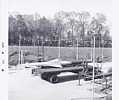
Training missile in the fueling area
The Nike Ajax used "interesting" liquid fuels, which needed periodic inspection and service.
An area with surrounding earth berm was used for this operation.
Image from Stan Wolverton via
Bill Siegfried, .
To: Kenneth A. Turner, Macon GA
I noticed the earthened berms around a above-ground SAC defense site had
3 small dug-out bunkers on the opposite side of where the Hercs were kept.
Stairs led on both sides to these small bunker doors which I assume are
there for the launcher crews to take cover when the missile is fired.
Berms also surrounded the warheading building.
"
Concerning ... sustaining the rate of fire and
reloading, you might recall the launchers are arranged by section in the
launch area. A section normally consisted of four launchers arrayed in
a line connected by transport and handling rails. Another section or
sections would be similarly arrayed nearby. For every four launchers,
there was usually an underground magazine where the missiles were
stored. If the magazine was a type "B" or type "D" magazine, there was
a launcher on the elevator, and three other "satellite" launchers above
ground (one launcher to the right of the elevator, two launchers to the
left as you face the principal direction of firing). With this
arrangement, you had several options on how you fired the missiles at a
sustained rate.
Also see Launchers about aiming the launchers so that
the boosters land in this area.
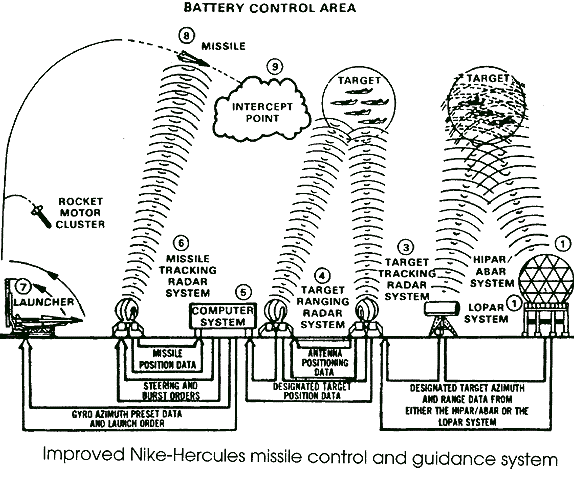
From FM 44-1-2 ADA Referennce Handbook, 15 June 1984,
see page 21 "Rings of Supersonic Steel"

